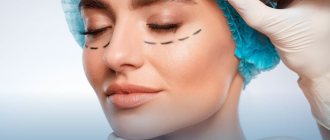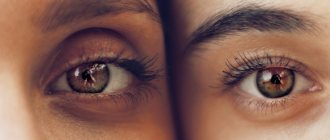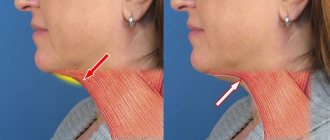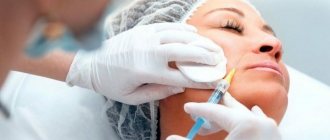Blepharoplasty is a surgical (plastic) operation that helps get rid of excess skin and fat in the upper and lower eyelids. As a result, the face (skin around the eyes) takes on a more toned and fresh appearance. However, this is not only a cosmetic procedure: such an intervention can solve defects that worsen a person’s quality of life. The medical indication for blepharoplasty is eyelid ptosis. There are several types of such operations: upper blepharoplasty, lower blepharoplasty, transconjunctival blepharoplasty. They differ from each other in the area of influence. After the consultation, the specialist will tell you which blepharoplasty is suitable in your case.
Indications for surgery
Typically, blepharoplasty is performed on middle-aged and older patients in order to correct age-related changes and make the look youthful and open. Main indications:
- bags and hernias under the eyes, in the lower eyelids.
- pronounced signs of aging: deep wrinkles, folds;
- undesirable anatomical features (for example, lack of volume, thin skin and translucent vessels).
Plastic surgery can significantly improve the overall appearance. After the intervention, your eyes become larger, your gaze becomes wide-open - even if you are not planning additional anti-age procedures, correction of the periorbital area will help you take off several years.
The effect is especially noticeable if the patient’s main problem was fatty hernias of the lower eyelids (popularly called “bags”). Excess fat tissue in this area makes the face tired and gloomy. By getting rid of excess, you can noticeably refresh your face as a whole. Blepharoplasty can also be combined with other types of surgical interventions (for example, correction of the chin and neck area, circular lift). In this case, the rejuvenating effect will be most pronounced.
Types and methods of plastic surgery
Eyelid surgery is performed using several methods, each of which has its own characteristics. The main goal of the intervention is to strengthen muscle structures, redistribute fatty tissue located under the skin of the eyelids.
Classic method
Surgical blepharoplasty involves removing excess skin and fatty tissue through a thin incision along the edge of the lower eyelids. Excess skin in the eyelid area is excised, the wound is sutured with special suture material - after healing, a thin, almost invisible scar remains.
Transconjunctival method
In this case, access to the subcutaneous fat is achieved through micro-incisions in the conjunctiva. The surgeon removes excess eyelid tissue in the amount that was determined before the intervention, or redistributes it if necessary. A wound on the mucous membrane after plastic surgery does not need to be sutured; this is done only in rare cases. The patient is given a pressure bandage for several hours.
This method is considered gentle, but it has limitations - if a large amount of tissue needs to be excised, transconjunctival blepharoplasty will not be suitable.
Surgery with canthopexy
In this case, plastic surgery is performed with a change in the shape of the eyes - the outer edge of the eyelids is lifted. Canthopexy can also be performed separately if the patient is not satisfied with the “sad” shape of the eyes with drooping corners, and there are no visible defects under the eyes.
Laser method
A modern, low-traumatic method that does not involve surgical incisions in the skin of the eyelids. The impact on tissue is carried out with a laser beam. Penetrating deep into the tissue, the laser causes microdamage to it. As a result, regeneration processes are activated in the skin, collagen and elastin begin to be actively produced. The result is denser, more elastic and tightened skin of the lower eyelids.
We actively use this method, primarily because it allows us to achieve excellent results without wounds or noticeable damage to the skin of the eyelids. Laser plastic surgery of the lower eyelids does not leave any scars; it has a very short rehabilitation period—in just one and a half to two weeks, the patient will be able to evaluate the changes that have occurred and return to their normal lifestyle. The price of such an intervention is higher than the cost of a classic operation, but it has significant advantages, and many choose this route.
When to do blepharoplasty: expert opinion
Plastic surgeons recommend doing the first procedure at the age of 35-40. At this age, the aging process has already begun, and timely surgery will make it possible to avoid scars - marks on the skin will remain almost invisible.
Since blepharoplasty stops aging only temporarily, the operation will need to be repeated. The best age is 50 and then 65 years.
To understand what results you will get, you can read reviews about blepharoplasty on forums. Almost all patients are satisfied with the result. The main thing is to approach the task responsibly and choose a good specialist.
You can get advice from the best surgeons in Moscow at the SM-Plastika plastic surgery clinic. The “Our Experience” section will introduce you to the results of such operations.
What result should I expect?
It all depends on the nature of the problem. If you were unhappy with the presence of bags under your eyes, lower eyelid surgery will eliminate this defect completely. If the problem was deep folds or a pronounced tear trough, eyelid skin tightening can be combined with lipofilling - the relief will be leveled, the skin will become more elastic and dense.
Blepharoplasty with canthopexy will lift the outer edges of the eyes - the face will look more fresh and joyful (subconsciously drooping edges of the eyes are perceived as a sign of sadness).
Cost of lower blepharoplasty
RUB 51,000
Make an appointment
Preparation for the procedure
Everything will depend on the method the doctor chooses. Laser blepharoplasty is considered a low-traumatic intervention. It is performed on an outpatient basis, it has a minimum of contraindications and practically does not cause discomfort. No special training is required either.
If you need classic blepharoplasty (using a scalpel), the preparation will be the same as for any other operation. You will need to undergo general clinical tests (blood and urine), a blood coagulogram (to determine if there are any problems with clotting), and an ECG. Such interventions are performed under general anesthesia, and the doctor must be informed about all your chronic diseases and medications you are taking, if you are allergic to any medications, etc.
Before the operation (about 8 hours) you will need to refuse food. There should be no wounds or damage in the lower eyelid area. Blepharoplasty is also not performed if there are signs of allergies (itching, redness of the eyes).
Is it true that blepharoplasty is very painful?
Any operation is an intervention in the body, and of course, one cannot expect pleasant sensations from it. It will be somewhat unpleasant for you during blepharoplasty. But we use exclusively high-quality painkillers that will reduce discomfort to a minimum.
The skin of the eyelids is indeed a very sensitive area. After the operation, there will definitely be pain in the places where the stitches are placed. But this, firstly, indicates that everything went correctly, and secondly, it can be relieved with painkillers. Discuss the choice of drug with our specialist - he will help you choose the most suitable remedy.
Some of our patients note that the healing sutures itch quite a lot. This can also cause some discomfort, but like the previous described effects, it passes relatively quickly.
How is the operation performed?
- Through an incision in the skin of the eyelids or on the mucous membrane, the doctor gains access to the area of interest, separates and excises excess skin and fatty tissue. If blepharoplasty was performed percutaneously, a thin suture is applied to the lower eyelid area.
- When accessing through the mucosa, sutures are usually not applied. In both cases, the patient can return home on the same day of surgery.
Laser plastic surgery is performed under local anesthesia. The patient's eyes are covered with special protective lenses before treatment begins. This makes it possible to get as close to the eyelash edge as possible without risk. Using a special attachment, the doctor will treat the problem area, and on the same day the patient will be able to return to their usual activities.
The essence of the eyelid correction procedure
A distinction should be made between anti-age surgery and the so-called Asian blepharoplasty (also called Singapore/Sangapuri).
In the case of Asian eyelid correction, the surgeon artificially creates a fold of the upper eyelid, which is usually absent in people of the Mongoloid race, and changes the shape of the eyes. This operation, extremely popular in South Korea, China and Japan, is not so common in Russia, but a certain proportion of such interventions are carried out here.
And yet, in our country, anti-aging blepharoplasty is in greatest demand.
The technique of this intervention involves excision of excess skin and subcutaneous fat and simultaneous strengthening of muscles and ligaments in the periorbital area.
The skin of the eyelids is very thin and quickly loses its elasticity and tone. Following the skin, other soft tissues of the area around the eyes begin to undergo age-related metamorphoses. As a result, wrinkles, furrows and folds are formed, fatty hernias and swelling are formed.
An eyelid lift performed by a qualified plastic surgeon can eliminate these aesthetic problems radically and permanently.
Who is blepharoplasty indicated for?
This aesthetic procedure can be performed at any age; the operation leaves no noticeable marks and is well tolerated by patients.
The fairly low cost of blepharoplasty surgery makes it accessible to almost anyone.
Indications for blepharoplasty (what this operation can do):
- elimination of sagging skin of the lower and upper eyelids;
- correction of “bags” under the eyes;
- correction of wrinkles around the eyes;
- correction of drooping corners of the eyes;
- elimination of fatty hernias of the eyelids;
- change in the shape of the eyelids (including the “Asian eyelid”).
Some diseases and conditions may become an obstacle to the operation.
Contraindications for eyelid blepharoplasty:
- bleeding disorders;
- diseases of the heart and blood vessels;
- oncopathology;
- infectious and inflammatory eye diseases;
- increased intraocular pressure;
- diabetes mellitus, etc.
Rehabilitation after blepharoplasty
After the operation is completed, the doctor applies a sterile bandage to the lower eyelid area. Sutures, if the access was percutaneous, are usually removed within 4-5 days. Immediately after blepharoplasty and for a few more days, you will need to observe certain restrictions.
Firstly, they relate to physical activity: you cannot play sports or do hard work. It is undesirable to sleep on your stomach and lean forward - this can cause severe swelling in the lower eyelid area. Activities that require visual stress should be avoided for about two weeks. It is also not recommended to go out in the sun without sunglasses.
After about 4 days, you will need to come in for an examination with a surgeon so that he can assess how the healing process is going. Thin crusts form in the area of the incisions - you need to be as careful as possible with them. They should not be rubbed, combed or wet - this can lead to infection of the wound. You also cannot use cosmetics. During the first days, the eyelid skin should be treated with antiseptics.
Recovery period after surgery
Sutures after blepharoplasty are not removed, as special absorbable threads are used.
In the first days after surgery, swelling is observed: this is a natural reaction of the body. Swelling can be reduced by applying cold compresses.
Patients must also adhere to certain rules for speedy rehabilitation after blepharoplasty:
- eliminate stress on the eyes and eyelids (reading, computer, TV, contact lenses, bright light);
- give up smoking and alcohol (to avoid major swelling), and salty foods;
- sleep only on your back using a high pillow;
- replace contact lenses with glasses for a month;
- try not to tilt your head;
- protect eyelids and eyes from external influences (wind, bright light, cosmetics, soap);
- wash your face with chamomile decoction;
- avoid baths and saunas;
- carefully perform special eye exercises.
The rehabilitation period lasts from 7 to 10 days. A person can return to work after 2 weeks. The result will be noticeable immediately after the operation, but the final effect will become obvious only after a month. Following the rules of eyelid skin care will allow you to preserve it for as long as possible, sometimes this period is more than ten years.
Contraindications
Blepharoplasty is not performed for people with severe endocrine diseases, chronic diseases of the cardiovascular system, or bleeding disorders. Also, the operation cannot be performed if the patient has a tendency to form keloid scars or eye diseases (conjunctivitis, blepharitis, dry eye syndrome, etc.).
To find out the price for eyelid surgery in our clinic in Moscow, call us or leave a request on the website. Our specialists will promptly contact you and schedule a consultation.
Advantages of the EMC Clinic
Plastic surgery on the eyelids includes a number of different correction options and requires the highest qualifications and precision from the specialist. Blepharoplasty at the EMC clinic is the best plastic surgery specialists with international practice and extensive practice, mastering the most complex methods of eyelid correction.
Innovative technical equipment, a modern fully equipped operating unit, the possibility of a comprehensive examination before surgery, and a postoperative hospital allow the EMC Aesthetic Clinic to maintain the highest level of medicine in Moscow.











